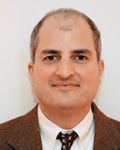Article
Telemedicine screening seen as effective approach for diabetic retinopathy
Baltimore—Given that many people fail to receive preventive screening for diabetic retinopathy or regular follow-up once diagnosed, telemedicine screening warrants a role in the effort to manage this disease better, according to Alan R. Malouf, MD, FACS. Dr. Malouf spoke at the Current Concepts in Ophthalmology meeting here, sponsored by Johns Hopkins University School of Medicine and Ophthalmology Times.

"Despite our best efforts, it is estimated that 30% to 45% of American adults do not receive recommended eye care to detect and treat diabetic retinopathy," said Dr. Malouf, who is past president of the Maryland Society of Eye Physicians and Surgeons and also a councilor from Maryland to the American Academy of Ophthalmology (AAO). "A well-tolerated method of evaluating the level of diabetic retinopathy yearly is needed so that the appropriate referral can be made."
Many excellent studies have been performed on the effectiveness of remote screening in ophthalmic disorders, with fairly consistent results, said Dr. Malouf, who practices in Bowie, MD. One such article published in 1993 compared clinical examinations with fundus photograph evaluations in detecting diabetic retinopathy. In a population of 1,168 patients with and without diabetes, the frequency of diabetic retinopathy by clinical examination was 7.7%, compared with 8.7% by fundus photograph evaluation.
"Second, we must ensure that the system's performance meets standard, established criteria," he added. This includes observation by a trained professional or an additional field photographic evaluation. Third, technical standards for image handling must be developed, and fourth, there is a need for studies evaluating interpretation of the images.
Other studies include a 2003 report showing that the performance of a fully automated computer digital analysis of images was the same as that of human experts. Another study reported the results of 52 patients whose digital images were remotely screened by a skilled observer. Imaging matched clinical exam diabetic retinopathy levels in 82% and was within one level in 100%.
Dr. Malouf also cited a study of a cluster of 19 patients digitally screened in which observers found that 59% had at least one nondiabetic ocular finding of a severity necessitating referral.
"The validity of digital teleimaging is therefore well established and indisputable," Dr. Malouf said. "Does that mean we can relegate responsibility of diabetic evaluation to reading centers? Is this an adequate examination for our patients with diabetes?
"What do our patients gain? At least they get screened," he continued, noting that insurance and HEDIS data suggest that the current system could be better.
Proposing potentially negative aspects of telemedicine screening, Dr. Malouf wondered whether patients lose anything if they do not have personal contact with an ophthalmologist or optometrist, or whether telescreening is also appropriate for conditions such as cytomegalovirus retinitis.
In light of favorable studies of telemedicine screening, the Maryland Society of Eye Physicians and Surgeons recently submitted a recommendation to the AAO calling for development of a detailed position paper on telemedicine for screening of diabetic retinopathy using the DigiScope (a highly specialized digital camera) or other similar devices. Such an initiative should explore the risks and benefits of this screening methodology as well as the potential monetary ramifications, Dr. Malouf said.
The AAO's ophthalmic practice group agreed that the AAO should develop a stand-alone statement on use of the DigiScope and/or telemedicine to screen patients for diabetic retinopathy while noting that this approach would not replace a comprehensive eye evaluation by an ophthalmologist.
"The answer to the question 'is telemedicine screening for diabetic retinopathy good for our patients?' is yes. Is a face-to-face examination even better? Sure. But at least 40% of our diabetic patients never see our face," Dr. Malouf concluded.
Newsletter
Don’t miss out—get Ophthalmology Times updates on the latest clinical advancements and expert interviews, straight to your inbox.




